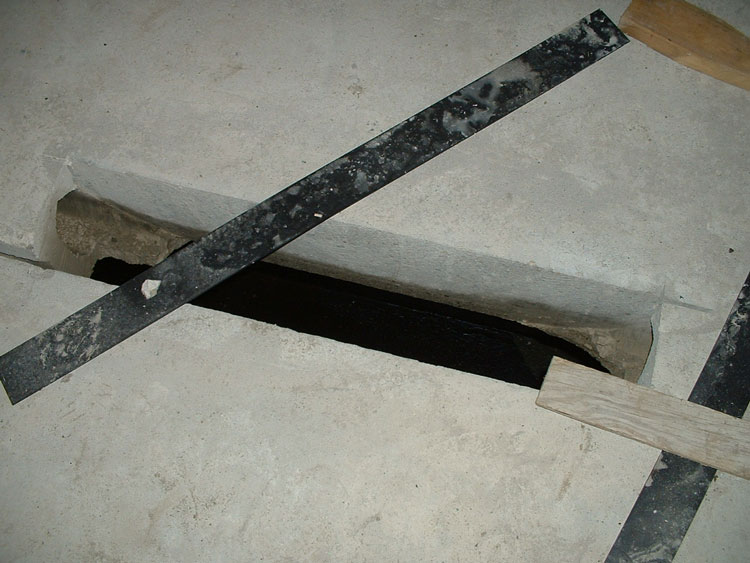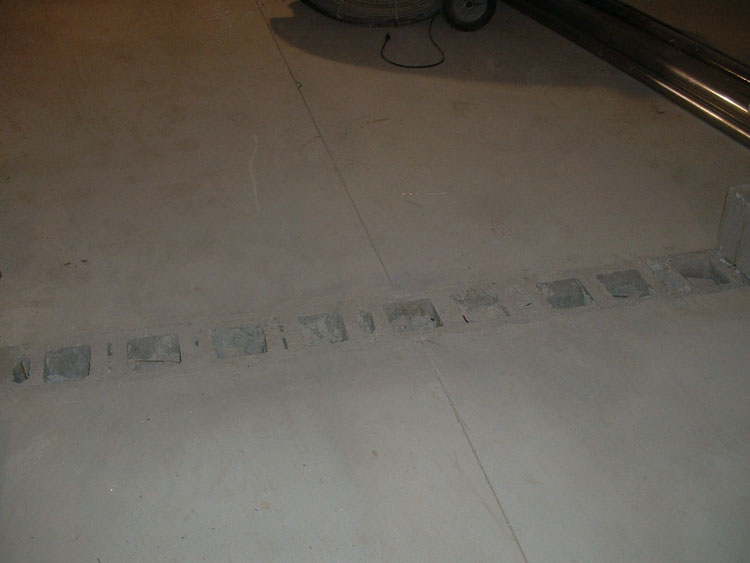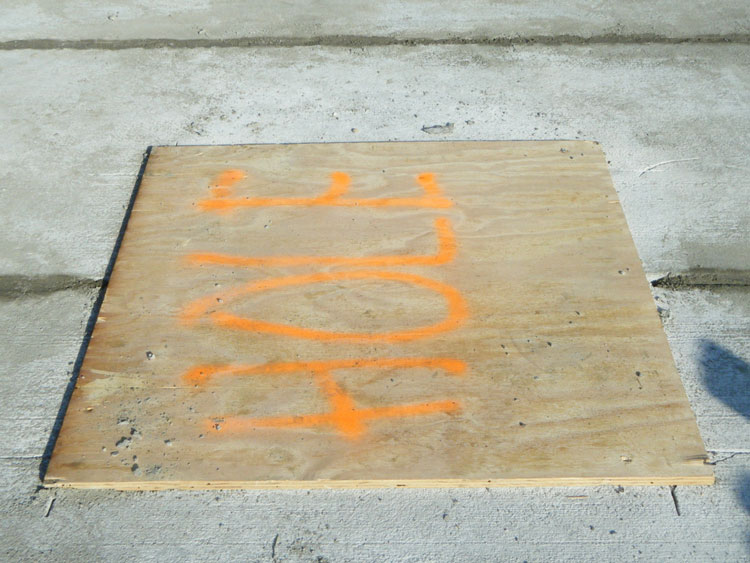
Photos and article by Gregory Havel
For work in buildings under construction and remodeling in the United States, the Occupational Safety and Health Administration (OSHA) in 29 CFR 1926.500 states “Hole means a gap or void 2 inches (5.1 cm) or more in its least dimension, in a floor, roof, or other walking/working surface.” This definition suggests that the standards are concerned not only with holes large enough for a worker to fall through, but also with those holes that could catch a heel or toe and trip a worker.
OSHA’s 29 CFR 1926.501 (b)(4) “Holes” states:
(i) Each employee on walking/working surfaces shall be protected from falling through holes (including skylights) more than 6 feet (1.8 m) above lower levels, by personal fall arrest systems, covers, or guardrail systems erected around such holes.
(ii) Each employee on a walking/working surface shall be protected from tripping in or stepping into or through holes (including skylights) by covers.
(iii) Each employee on a walking/working surface shall be protected from objects falling through holes (including skylights) by covers.
Holes that require covers do not have to be large enough for a worker to fall through.

(1)
Photo 1 shows an opening in a precast concrete plank subfloor, which measures approximately six inches wide by 30 inches long (15.2 cm by 76.2 cm). Since the smaller dimension of this hole is greater than two inches (5.1 cm), it must be covered.

(2)
Photo 2 shows concrete floors that have been poured flush with the top of an eight-inch (20.3 cm) wall of concrete masonry units (CMU). Since the open cores in the CMU measure about four inches (10.1 cm) square, these openings must be filled or covered.

(3)
Photo 3 shows the opening that has been provided around a floor drain in a concrete floor, so that the elevation of the drain’s grating may be precisely adjusted to the elevation of the finished floor. Since this opening is greater than two inches on any side of the drain, it must be covered until the final adjustment of the drain’s elevation has been made, and until the open space has been filled with concrete or grout.
OSHA’s 29 CFR 1926.502 (i) states: “Covers for holes in floors, roofs, and other walking/working surfaces shall meet the following requirements:
(1) Covers located in roadways and vehicular aisles shall be capable of supporting, without failure, at least twice the maximum axle load of the largest vehicle expected to cross over the cover.
(2) All other covers shall be capable of supporting, without failure, at least twice the weight of employees, equipment, and materials that may be imposed on the cover at any one time.
(3) All covers shall be secured when installed so as to prevent accidental displacement by the wind, equipment, or employees.
(4) All covers shall be color coded or they shall be marked with the word “HOLE” or “COVER” to provide marking of the hazard.

(4)
Photo 4 shows a cover over a hole that is approximately 42 inches (106.7 cm) square. It has been screwed to the concrete subfloor to prevent its accidental displacement or removal; and has been marked with fluorescent orange paint “HOLE”, as required by the OSHA standards. Since this cover is intended to support only foot traffic, the ¾-inch (two cm) plywood cover is adequate.

(5)
Photo 5 shows a plywood cover over a hole that was intended to support only foot traffic (about 250 pounds or 113 kg), and which failed when one wheel of a 3,500-pound (1,590 kg) scissors lift was driven onto it. The load imposed on this cover by the one wheel was 875 pounds (398 kg), about three times more weight than the cover was designed to carry with the required safety factor. Fortunately, the scissors lift was not fully loaded; was not elevated; and did not tip over in this incident.
Please note that almost any temporary hole cover will rest upon the surface of the floor or roof and will present a trip hazard to the unwary. The heavier the weight the cover is designed to carry, the thicker it is likely to be. The risk of an injury from a trip is considered acceptable in this instance, when compared to the injuries (sprains and fractures) likely to be incurred from catching a toe or heel in a small hole; or when compared to the injuries (fractures and internal injuries) and fatalities that are likely if a worker falls through a larger hole to a lower level.
During inspections and tours of construction job sites, we must be wary of hole covers. Even these simple solutions to larger problems can trip and injure us. These are the times to discuss with the contractor’s superintendent or foreman the loads these covers are designed to carry. We can preplan our emergency response so that we will not exceed the safe design of these covers. In addition to the required “HOLE” painted on the cover, some contractors will add the calculated safe load on the cover with the required safety factor, as “MAX. LOAD 250 POUNDS.” Some contractors will also spray the edges of hole covers with fluorescent orange paint, to draw attention to the potential trip hazard.
Some simple precautions during emergency operations in buildings where hole covers are present:
- Do not walk on or work from hole covers unless there is no alternative
- A hole cover designed to support 250-pound individual foot traffic should support a single firefighter wearing full personal protective equipment; but may not support the firefighter plus the ladder, tools, or rolled hose that is being carried.
- A hole cover designed to support 250-pound foot traffic may not support an ambulance cot, patient, and the attending EMTs/paramedics without failure. Among the factors that can lead to failure of the cover are the weight of the cot; weight of the patient; weight of the attendants; the size of the hole; and the diameter and width of the cot’s wheels.
- Never set a ladder on a hole cover. Although the cover may not fail from the point loading of the ladder’s spurs, it will almost certainly fail while firefighters are on the ladder. Find another ladder access point to the upper level, or use a stairway.
Occupational Safety and Health Administration standards and regulations for the United States are free downloads from www.osha.gov. Click on “Regulations,” then on “Laws and Regulations,” then on “Construction.” Scroll down to find the topic you need and click on it. Note that most of the OSHA safety standards are not included in either fire or building codes.
Canada and other nations have similar safety standards and regulations, which are the authority within the boundaries of those nations and their territories. An Internet search for “construction safety [nation]”, or a similar search, should include a link to that country’s equivalent of US OSHA and its standards or regulations; unless those documents are available only in print.
Download this article as a PDF HERE (1.6 MB).
 Gregory Havel is a member of the Town of Burlington (WI) Fire Department; retired deputy chief and training officer; and a 35-year veteran of the fire service. He is a Wisconsin-certified fire instructor II, fire officer II, and fire inspector; an adjunct instructor in fire service programs at Gateway Technical College; and safety director for Scherrer Construction Co., Inc. Havel has a bachelor’s degree from St. Norbert College; has more than 35 years of experience in facilities management and building construction; and has presented classes at FDIC International and other venues.
Gregory Havel is a member of the Town of Burlington (WI) Fire Department; retired deputy chief and training officer; and a 35-year veteran of the fire service. He is a Wisconsin-certified fire instructor II, fire officer II, and fire inspector; an adjunct instructor in fire service programs at Gateway Technical College; and safety director for Scherrer Construction Co., Inc. Havel has a bachelor’s degree from St. Norbert College; has more than 35 years of experience in facilities management and building construction; and has presented classes at FDIC International and other venues.
MORE CONSTRUCTION CONCERNS
Thermal Breaks
Galvanic Corrosion
Corrosion Protection in Dry-Pipe Systems
Corrosion
Shotcrete

